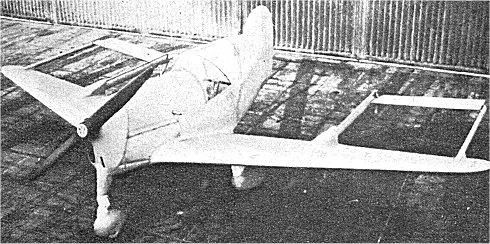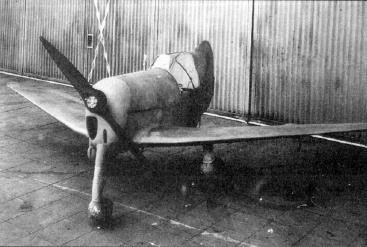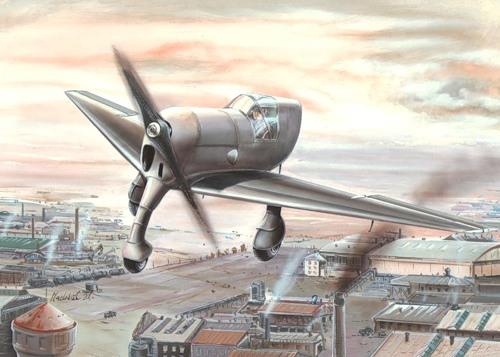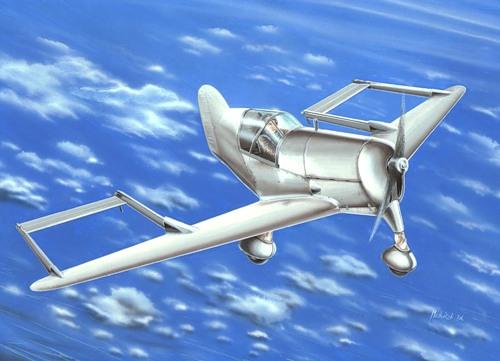| Type |
|
| Engine |
|
| Dimensions |
Length 4,50 m, height , span 6,00 m |
| Weights |
Empty , loaded , max. take off weight |
| Performance |
Max.. speed , cruising speed , range , endurance , service ceiling , climb |
| Type |
Werk.Nr |
Registration |
History |
|
|
|
The first of Otto Kauba's prototypes, the SK V1A, was intended as a predecessor of a flying bomb, and was the first aircraft to feature the unique trailing elevons. |





However, Kauba's first task was to determine the flying characteristics of the unusual configuration that he proposed (for a flying bomb), and he accordingly designed a weird low-wing cantilever monoplane powered by a 105 hp Hirth HM 504A-2 air-cooled inline engine driving a two-blade tractor airscrew, and featuring all-metal construction, a fixed nosewheel undercarriage, and the unique trailing elevons. In its initial form, the aircraft was to have an orthodox cockpit for a pilot, the intention being to replace this with an explosive charge after proving the flying characteristics of the machine. Guidance would then be by means of an autopilot and height and range-setting controls, the servo mechanisms controlling the elevons which were the only aerodynamic controls. The wing span and overall length were 19 ft 8 in (6 m) and 14 ft 9 in (4,5 m) respectively, loaded weight was 1,323 lb (600 kg), and anticipated maximum speed exceeded 155 mph (250 km/h).
The RLM instructed Kauba to proceed with the construction of four prototypes, and the first of these, designated SK VIA, was duly completed and transported by road to the Prague-Gbely airfield from which one of Messerschmitt's test pilots was intended to conduct initial flight trials. After a cursory inspection of the SK V I A, the German pilot refused to fly the "strange contraption". Another German pilot, an instructor from the Luftwaffe's flying training school at Vyskov in Moravia, was asked to undertake the flight testing, but he too refused, and in desperation, Kauba approached the management of the Skoda Works to find him a pilot. Accordingly, Petr Siroky, Avia's chief test pilot and a well-known Czech aerobatic pilot, was ordered to undertake the initial flight trials.
Having discovered the eventual purpose of the aircraft, Siroky, too, refused the task, but veiled threats and suggestions of Gestapo interest in himself and his family resulted in what appeared to be a change of heart. In fact, Siroky, with Avia director Cajthamel, was already planning the deliberate destruction of the aircraft, and after a few taxying trials across the Prague-Gbely airfield, Siroky did actually take-off, but as soon as he was airborne he began to switch the ignition on and off so that onlookers would think that the engine was behaving erratically. Then, finally cutting the power completely and with the airscrew windmilling, he put the nose down and bounced the aircraft on its nosewheel. The aircraft somersaulted several times and finally came to rest on its belly, the undercarriage having been wiped off. Siroky was carried unconscious from the wrecked aircraft, but Kauba was suspicious and immediately accused the pilot of sabotage. Fortunately for Siroky, Cajthamel intervened and Kauba dropped his charges.
After this setback RLM interest in Kauba's proposals began to wane, but in 1943, as a result of representations made by a Nazi director of the Skoda Works, work was resumed and the second prototype, designated SK V1, was finished. Essentially similar to its predecessor apart from having a rudder, the SK V1 was flown successfully by Rudolph Opitz who had been flight testing the radical Messerschmitt Me 163 at Peenemunde . Trials were conducted from the Prague-Ruzyn airfield, and the aircraft was found to be somewhat nose heavy.




